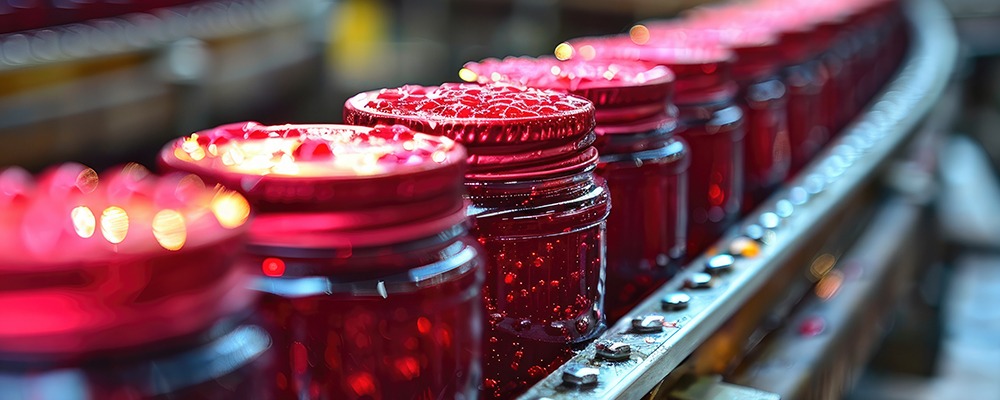The art of preserving fruits in the form of jams and preserves has been around for centuries, offering a delicious way to enjoy seasonal fruits all year round. The process of making jams, jellies, and preserves involves cooking fruit with sugar, and sometimes pectin, to create a thick, spreadable product. However, one challenge that many producers face in jam and preserve production is the viscosity of the fruit mixture. Achieving the perfect texture while maintaining a smooth and consistent product requires careful management of pectin levels in the fruit. This is where pectinase enzymes come into play, revolutionising the way jams and preserves are made.
What is Pectinase?
Pectinase is a group of enzymes that break down pectin, a naturally occurring substance found in fruits that helps hold the cell walls together. Pectin plays a significant role in the gelling process of jams and jellies, but too much pectin can result in a jam that is overly thick or difficult to spread. By using pectinase enzymes, producers can modify the level of pectin in the fruit mixture, allowing them to control the consistency of the final product. The result is a smoother, more easily spreadable jam, preserve, or jelly that retains its natural flavour and texture.
Pectinase enzymes are typically extracted from fungal or bacterial sources, and they are specifically designed to target and break down pectin, converting it into simpler sugars and other components. This process is known as enzymatic hydrolysis, and it can be controlled to ensure that the breakdown of pectin is tailored to the desired consistency of the final product.
Why Use Pectinase Enzymes in Jam & Preserve Production?

The use of pectinase enzymes in the production of jams and preserves offers numerous benefits, both for manufacturers and consumers alike. Let’s explore some of the key advantages that pectinase enzymes bring to the table.
1. Improved Yield
One of the main challenges in jam and preserve production is achieving the desired yield while minimising waste. Pectinase enzymes help by breaking down the pectin present in fruit, releasing more juice and pulp from the fruit cells. This increased yield means that producers can create more jam or preserve from the same amount of fruit, improving overall efficiency and profitability.
2. Enhanced Clarity
In traditional jam-making, excess pectin can lead to cloudiness or a cloudy appearance in the final product. This can be especially problematic for fruit preserves, where clarity and transparency are often desired. By using pectinase enzymes, the breakdown of pectin helps to clear the fruit mixture, resulting in a more aesthetically pleasing, clearer product.
3. Faster Processing Time
The enzymatic process of breaking down pectin is much faster than the traditional method of heating the fruit mixture for extended periods. By using pectinase, manufacturers can significantly reduce the time it takes to make jams and preserves, speeding up the production process and increasing overall throughput. Faster processing time can lead to lower energy consumption, reduced operating costs, and the ability to produce larger quantities in shorter time frames.
4. Consistent Product Texture
Pectinase enzymes help achieve a more consistent texture in the final product. When pectin is broken down, it ensures that the jam or preserve has a smoother, more uniform texture throughout. This consistency is key for manufacturers who want to meet the expectations of their customers, whether it’s the smoothness of a jam or the perfect spreadability of a preserve.
5. Improved Shelf-Life
Pectinase enzymes can also contribute to the preservation of jams and preserves by reducing the chances of crystallisation. Sugar crystals can sometimes form in jams and preserves over time, affecting both the texture and the flavour. By breaking down the pectin, pectinase enzymes help to reduce the formation of these unwanted crystals, improving the shelf-life of the final product and ensuring it remains of high quality for longer.
How Does Pectinase Work?

Pectinase works by hydrolysing the pectin in the fruit mixture. Pectin is a complex polysaccharide found in the cell walls of many fruits, and it is responsible for providing structure and stability to the fruit. When pectinase enzymes are added to the mixture, they break down the pectin molecules into smaller fragments, which results in a decrease in viscosity. This breakdown allows the fruit to release more juice and pulp, which is essential for the gelling process of jams and jellies.
The amount of pectinase used in the production process can be adjusted depending on the desired outcome. By controlling the dosage and timing of the enzyme treatment, manufacturers can tailor the texture of the jam or preserve to their specific needs, achieving a perfect balance between spreadability and firmness. This level of control allows for the production of jams and preserves with varying levels of sweetness, thickness, and texture, meeting the preferences of different consumers.
Pectinase in the Modern Food Industry
In recent years, the demand for natural and organic food products has led many food manufacturers to seek alternative solutions to traditional food processing methods. Enzyme technology, including the use of pectinase, has become an essential tool for food manufacturers who want to meet consumer demands for clean-label products without compromising on quality.
The use of pectinase enzymes also aligns with the growing trend towards sustainable food production practices. By reducing processing time, energy consumption, and waste, pectinase enzymes contribute to a more eco-friendly approach to jam and preserve production. As sustainability becomes increasingly important in the food industry, the adoption of enzymatic solutions such as pectinase will likely continue to rise.
Conclusion
As the demand for high-quality, naturally processed food products continues to rise, enzymes like pectinase are proving to be indispensable tools for modern food manufacturers. Their ability to enhance yield, improve texture, reduce processing time, and support clean-label production makes them especially valuable in the creation of jams and preserves. By enabling greater control over the consistency and clarity of fruit spreads, pectinase enzymes not only streamline manufacturing but also elevate the consumer experience.
With its deep scientific expertise and commitment to eco-safe innovation, Biolaxi Enzymes continues to support the food processing industry with customised enzyme solutions like pectinase. Backed by stringent quality standards and responsive technical support, Biolaxi empowers manufacturers to achieve consistent results, enhance efficiency, and meet evolving market demands—all while promoting sustainable and cost-effective production practices.




